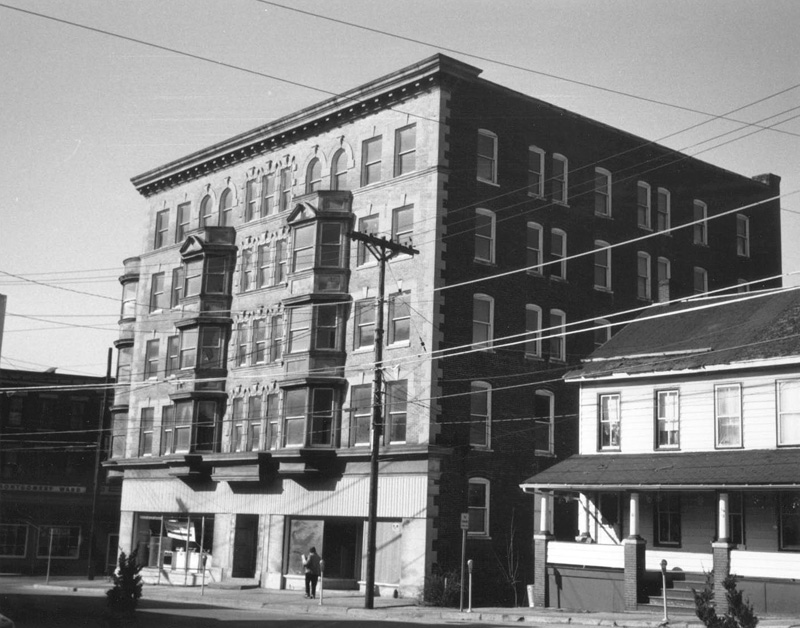Commercial style
The Commercial style (1890 - 1920) reflects advances in construction technology that permitted the creation of very tall buildings, the first skyscrapers in the urban landscape. This style is sometimes referred to as the Chicago style, after the city where steel-framed, relatively unadorned, utilitarian, tall commercial buildings first appeared in great numbers in the 1890s.
Advances in commercial architectural design in Philadelphia and New York City laid the groundwork for the full development of the Commercial style in Chicago.
William Le Baron Jenney was the first architect to employ the steel frame construction in his design for the Home Insurance building completed in Chicago in 1885. Other prominent architects who worked in the development of this new building technology included the firms of Adler and Sullivan (Sullivan's embellishment of this style became its own distinctive architectural style, the Sullivanesque), Burnham and Root, and Holabird and Roche. While the style thrived in Chicago at the turn of the 20th century, examples of the Commercial style can be found in many other cities.
Prior to the development of steel frame technology, building height had been limited by the need for massive masonry support walls. The strength of the steel skeleton allowed for much taller buildings without the bulk of heavy masonry walls. The invention of the lift also facilitated the design of tall buildings by making upper floors more easily accessible. Commercial style buildings reflecting this first wave of skyscraper construction are usually between six and twenty storeys in height.
The distinguishing characteristics of this style are a steel skeleton construction, expressed externally as a grid of intersecting piers and cross spandrels, a flat roof with modest cornice, and large bands of windows.
Windows often featured a projecting bay which extended from the ground floor to the top of building. Another common window type used for Commercial style buildings was the 'Chicago window', comprised of a large fixed central pane, flanked by two narrow casements for ventilation. The ground floor of Commercial style buildings usually contained large display windows for storefronts.
Some examples of this style employ decorative elements of other popular styles of the era, such as Romanesque or Gothic Revival ornament. Sullivan's uniquely curvilinear Art Nouveau inspired ornamental panels led to its distinction as a separate architectural style. Some buildings of Commercial style are very simple in design with no notable ornamentation or reference to past architectural styles. These bare bones commercial buildings were the precursors of even taller and more simplistic modern skyscraper design.
While the purest description of Commercial style buildings best fits early skyscrapers, many much shorter buildings are sometimes described as Commercial style. These 1-4 story brick buildings date from the same era, were designed for commercial use, have large pane windows on the ground floor and flat roofs, often with decorative parapets. Early car dealerships and repair shops often take this form with large windows or garage door bays on the ground floor. This sub-type of the style is a more vernacular version than the true high style Commercial style skyscrapers.
Identifiable features:
- Vertical emphasis: 6-20 storeys in height.
- Flat roofs.
- Masonry wall surfaces.
- Three part windows or projecting bay windows.
- Decorative cornices.
- Steel and beam construction.
- Ground floor storefronts.
--Pennsylvania Historical and Museum Commission
[edit] Find out more
[edit] Related articles on Designing Buildings Wiki
Featured articles and news
RTPI leader to become new CIOB Chief Executive Officer
Dr Victoria Hills MRTPI, FICE to take over after Caroline Gumble’s departure.
Social and affordable housing, a long term plan for delivery
The “Delivering a Decade of Renewal for Social and Affordable Housing” strategy sets out future path.
A change to adoptive architecture
Effects of global weather warming on architectural detailing, material choice and human interaction.
The proposed publicly owned and backed subsidiary of Homes England, to facilitate new homes.
How big is the problem and what can we do to mitigate the effects?
Overheating guidance and tools for building designers
A number of cool guides to help with the heat.
The UK's Modern Industrial Strategy: A 10 year plan
Previous consultation criticism, current key elements and general support with some persisting reservations.
Building Safety Regulator reforms
New roles, new staff and a new fast track service pave the way for a single construction regulator.
Architectural Technologist CPDs and Communications
CIAT CPD… and how you can do it!
Cooling centres and cool spaces
Managing extreme heat in cities by directing the public to places for heat stress relief and water sources.
Winter gardens: A brief history and warm variations
Extending the season with glass in different forms and terms.
Restoring Great Yarmouth's Winter Gardens
Transforming one of the least sustainable constructions imaginable.
Construction Skills Mission Board launch sector drive
Newly formed government and industry collaboration set strategy for recruiting an additional 100,000 construction workers a year.
New Architects Code comes into effect in September 2025
ARB Architects Code of Conduct and Practice available with ongoing consultation regarding guidance.
Welsh Skills Body (Medr) launches ambitious plan
The new skills body brings together funding and regulation of tertiary education and research for the devolved nation.
Paul Gandy FCIOB announced as next CIOB President
Former Tilbury Douglas CEO takes helm.
UK Infrastructure: A 10 Year Strategy. In brief with reactions
With the National Infrastructure and Service Transformation Authority (NISTA).
























